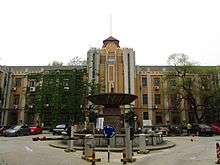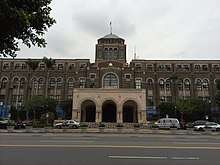Supreme Court of the Republic of China
| Supreme Court of the Republic of China 中華民國最高法院 | |
|---|---|
|
| |
| Established | 1927 |
| Country | Republic of China |
| Location | Taipei, Taiwan |
| Composition method | legislative selection/executive selection/ |
| Authorized by | ROC Constitution |
| Judge term length | Life tenure |
| Website | www.judicial.gov.tw |
| Chief Justice | |
| Currently | Zheng Yu-shan |
| Since | 2015 |
The Supreme Court of the Republic of China (Chinese: 中華民國最高法院; pinyin: Zhōnghuá Mínguó Zuìgāo Fǎyuàn) is the court of last resort in the Republic of China although matters regarding interpretation of the Constitution and unifying the interpretation of laws and orders are decided by the Constitutional Court of the Judicial Yuan.
History


The court in Taiwan (Formosa) was originally established in 1896, the second year after Taiwan became a part of Japan. The Taiwan High Court at this era, can be considered to be the de facto Supreme Court in Taiwan, because the case cannot be further appealed to the Supreme Court in Tokyo. After the second world war, Japan gave up its sovereignty on Taiwan, and the supreme court of Taiwan's judicial system has become the Supreme Court of the Republic of China.
The Supreme Court of the Republic of China was originally established as the Ta Li Yuan[1] (Chinese: 大理院; pinyin: Dàlǐ Yuàn) in 1909. After the Chinese reunification, the government of the Republic of China renamed the Dali Yuan to the Supreme Court in 1927 and made the Court the nation's court of last resort in 1928. On March 1949, the Court was moved to Canton with the Judicial Yuan. Shortly after in August 1949, the Court was moved to Taipei, Taiwan, where the Kuomintang government retreated after the Chinese Civil War. Originally it was located at Judicial Building at Chung-king South Road, but it was later moved to its current location on Chang-sha Street since 1992.[2]
Introduction
The Organic Law of the Court states that the judicial system shall be composed of the Supreme Court, High Courts, and District Courts, in which the system of “three-level and three-instance” is used.[3] The Supreme Court is the court of last resort for civil and criminal cases. Except for civil cases involving amounts not exceeding NT $1,500,000 and petty offences enumerated in Article 376 of the Code of Criminal Procedure, any civil or criminal case may be appealed to the Court.[4]
More specifically, the Court exercises jurisdiction over the following cases:[5]
- appeals from judgments of High Courts or their branches as courts of first instance in criminal cases;
- appeals from judgments of High Courts or their branches as courts of second instance in civil and criminal cases;
- appeals from rulings of High Courts or their branches;
- appeals from judgments or rulings rendered by the civil court of second instance by the summary procedure, the amounts in controversy exceeding NT $1,500,000, and with permission granted in accordance with specified provisions;
- civil and criminal retrials within the jurisdiction of the court of third instance;
- extraordinary appeals; or
- any other case as specified by laws.[5]
One thing special about the Supreme Court of Taiwan is that it has many chambers. Now there are 9 criminal chambers and 8 civll chambers, each consists of 5 judges. All the appeal cases are decided by these chambers. Because these chambers might have different opinions, the function of the Supreme Court to unify the construction of the law in the country is substantially diminished. In order to unify the opinions, judges in civil chambers and criminal chambers hold meetings regularly and make resolutions on legal questions. Those resolutions are not officially binding, but have de facto binding effect.
Procedure
Cases are forwarded to either the Civil Section or the Criminal Section, which will record the case according to the year, class of case, as well as order of receipt. The case is reviewed by the Rules for Initial Review of Civil and Criminal Cases. After review, if the Court finds the case is defective, it will send the case back to the original court or order the party to amend the defects. If the Court finds the case to be in good form, the case is then sent to the Case Assignment Subsection, which will assign the case to a certain justice. Cases before the Supreme Court are heard and decided by a panel of five judges, with the Division Chief Judge acting as the presiding judge and the chairperson in deliberation.[6]
The Court decides only issues of law, and must base its decision on the facts ascertained in the judgment of the court of second instance (High Court). An appeal may be made to the Court only on the grounds that the original judgment is in violation of law or order. Documentary review proceedings are the norm, but if necessary, the presiding justice hear oral arguments in which issues of law are debated.[6]
The Supreme Court has a President, who is of the special appointment rank and who is in charge of the administrative affairs of the entire court and who acts concurrently as a Judge.[7]
Presidents
- Yu Yuangao (5 November 1927 – 13 November 1928)
- Lin Xiang (13 November 1928 – 5 November 1932)
- Ju Zheng (5 November 1932 – 22 July 1935)
- Jiao Yitang (22 July 1935 – 26 September 1940)
- Li Ba (30 January 1941 – 3 February 1945)
- Xia Qin (3 February 1945 – 13 July 1948)
Post 1947 Constitution
- Xie Yingzhou(13 July 1948-1966)[8]
- Zha Liangjian(1966-1968)[8]
- Chen Pu-sheng(1968-1972)[8]
- Chien Kuo-cheng(1972-1987)[8]
- Chu Chien-hung(1987-1993)[8]
- Wang Chia-yi(1993-1996)[8]
- Ge Yi-tsai(1996-1998)[8]
- Lin Ming-te(1998-2001)[8]
- Wu Chi-pin(2001-2007)[8]
- Yang Jen-shou(2007-2012)[8]
- Yang Ting-chang(2012-2015)[8]
- Cheng Yu-shan (2015– )[9]
Prominent Judges
- Chang Chin-lan was the first female supreme court judge of the Republic of China.
See also
References
- ↑ Jianfu Chen (1995). From Administrative Authorisation to Private Law: A Comparative Perspective of the Developing Civil Law in the People's Republic of China. Martinus Nijhoff Publishers. pp. 15–. ISBN 0-7923-3200-8.
- ↑ See The Supreme Court of the Republic of China, History, available at http://tps.judicial.gov.tw/english/index.php?parent_id=300 (last visited Mar. 28, 2012)
- ↑ See Organic Law of the Court, Art. 1, available at http://law.moj.gov.tw (last visited Nov. 25, 2010)
- ↑ See The Supreme Court of the Republic of China, Preface, available at http://tps.judicial.gov.tw/english/index.php?parent_id=299 (last visited Mar. 28, 2012)
- 1 2 See The Supreme Court of the Republic of China, Jurisdiction, available at http://tps.judicial.gov.tw/english/index.php?parent_id=302 (last visited Mar. 28, 2012)
- 1 2 See The Supreme Court of the Republic of China, The Supreme Court's Procedure, available at http://tps.judicial.gov.tw/english/index.php?parent_id=565 (last visited Mar. 28, 2012)
- ↑ See The Supreme Court of the Republic of China, The Supreme Court's Organization, available at http://tps.judicial.gov.tw/english/index.php?parent_id=301(last visited Mar. 28, 2012)
- 1 2 3 4 5 6 7 8 9 10 11 See The Supreme Court of the Republic of China, Presidents, available at http://tps.judicial.gov.tw/about/?parent_id=588 (last visited 28 March 2012)
- ↑ "最高法院院長交接 鄭玉山上任". China Times. 27 October 2015. Retrieved 23 October 2016.
Further reading
- Chang-fa Lo, The Legal Culture and System of Taiwan, (Kluwer Law International 2006).
External links
| Wikimedia Commons has media related to Supreme Court of the Republic of China. |
- Official Website of the Supreme Court of ROC
- Taiwan Law Resources
- The Judicial Yuan
- The Ministry of Justice
- Taipei District Prosecutors Office
- Legislative Yuan
- Executive Yuan
Coordinates: 25°2′24″N 121°30′35.6″E / 25.04000°N 121.509889°E